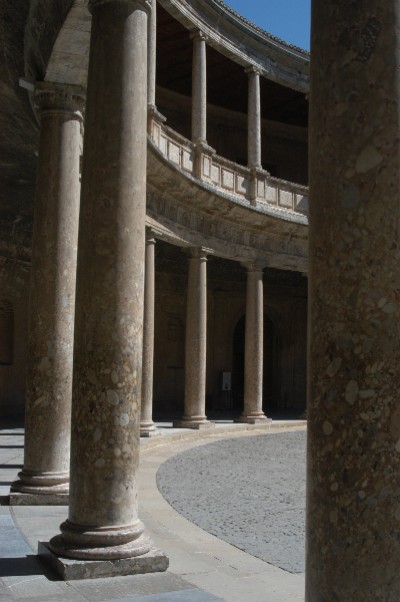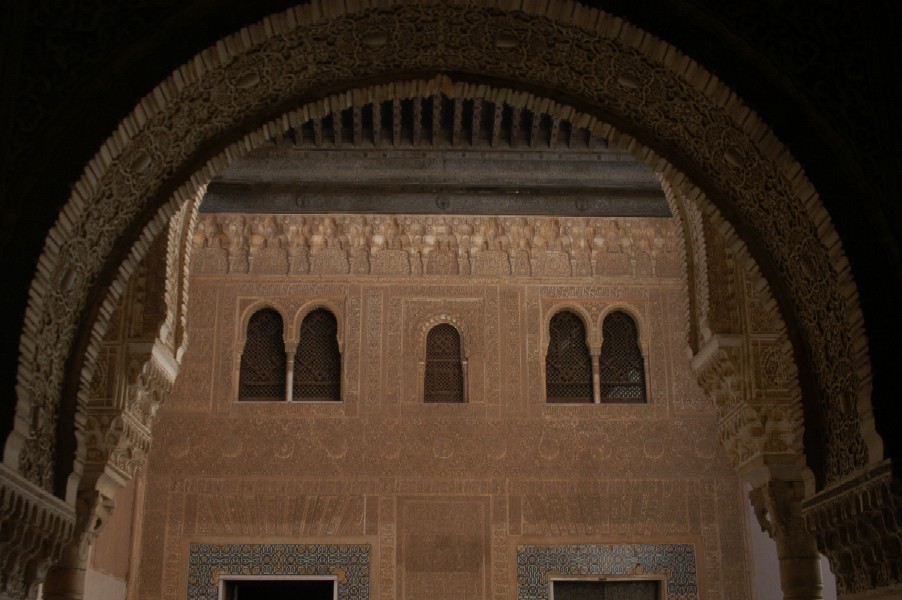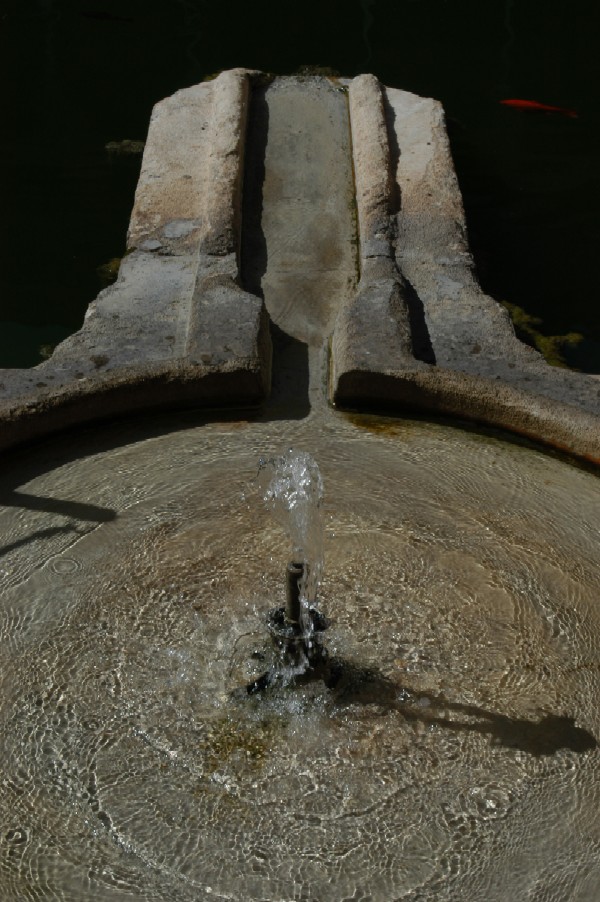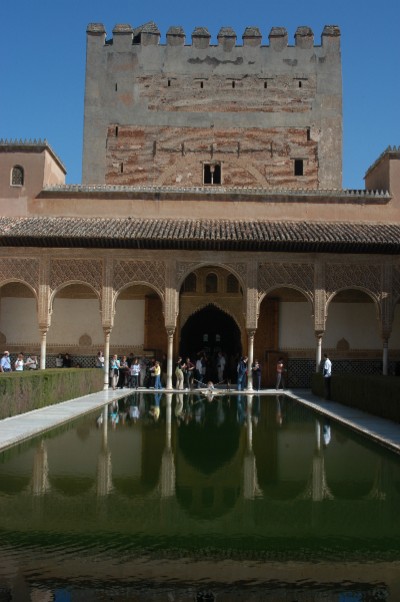THE ALHAMBRA "Part One" For the first two weeks we were in Granada we avoided making a visit to the Alhambra. The city swarmed with tourists during Semana Santa and the  week week  following we were inundated with tour groups, mostly French. It was the grand highlight of the city and when we decided to stay an extra two weeks it made sense to go when the Easter holiday crowds had thinned. I spent time reading Washington Irving's The Tales of Alhambra, an account of his three month stay in the crumbling fortification back in the 1820's, when the Alhambra was largely unknown to the world. He relayed a number of fairytales told to him by the people who were living there at the time, caretakers whose families had lived within the city walls of the Alhambra for generations. Irving settled himself in area of the palaces that had been reconstructed during the reign of Charles V and wrote descriptively about the exotic and romantic atmosphere of the buildings, hinting at their once glamorous past. Through the interest of Irving and other famous writers, the Alhambra became a national monument in 1870 and has since been carefully restored. following we were inundated with tour groups, mostly French. It was the grand highlight of the city and when we decided to stay an extra two weeks it made sense to go when the Easter holiday crowds had thinned. I spent time reading Washington Irving's The Tales of Alhambra, an account of his three month stay in the crumbling fortification back in the 1820's, when the Alhambra was largely unknown to the world. He relayed a number of fairytales told to him by the people who were living there at the time, caretakers whose families had lived within the city walls of the Alhambra for generations. Irving settled himself in area of the palaces that had been reconstructed during the reign of Charles V and wrote descriptively about the exotic and romantic atmosphere of the buildings, hinting at their once glamorous past. Through the interest of Irving and other famous writers, the Alhambra became a national monument in 1870 and has since been carefully restored.
The history of the Alhambra is a fascinating one, dating back to the Moorish conquest of the Iberian peninsula. The Moors arrived in 711 at the request of the Visigoths, who were seeking military support. The Moors were Arab led but were mostly ethnic Berbers and quickly dominated the entire region. The first signs of fortification on the sight of the Alhambra was the construction of the Alcazaba citadel in 889, the austere towers of which we could see from our small apartment window. The walls around the hilltop were added later and the interior palaces and city were constructed under the Nasarid Dynasty of Granada from about 1250. Mohammad ibn al-Ahmar ibn Nasr was the founding father of the Nasrid Dynasty. The name Alhambra was derived from the Arabic al-hamra which means read soil and was perhaps also in reference to the name of al-Ahmar. Even after the rest of Al-Andalus (Andalucia) had fallen to the Spanish his caliphate reigned from Granada for another 250 years. It even helped Castile's Fernando to take Seville and paid tribute to Castille until 1476. When emir Abu al-Hasan refused to pay tribute from 1476 and Castile and Aragon were united in the marriage of the Catholic monarchs, Isabel and Ferdinand, Granada's future was doomed. It fell to Spain in 1492. Its last emir, Boabdil, was given the region of the Alpujarras mountains, to the south of Granada, but he only remained there for a year before leaving for Africa. see from our small apartment window. The walls around the hilltop were added later and the interior palaces and city were constructed under the Nasarid Dynasty of Granada from about 1250. Mohammad ibn al-Ahmar ibn Nasr was the founding father of the Nasrid Dynasty. The name Alhambra was derived from the Arabic al-hamra which means read soil and was perhaps also in reference to the name of al-Ahmar. Even after the rest of Al-Andalus (Andalucia) had fallen to the Spanish his caliphate reigned from Granada for another 250 years. It even helped Castile's Fernando to take Seville and paid tribute to Castille until 1476. When emir Abu al-Hasan refused to pay tribute from 1476 and Castile and Aragon were united in the marriage of the Catholic monarchs, Isabel and Ferdinand, Granada's future was doomed. It fell to Spain in 1492. Its last emir, Boabdil, was given the region of the Alpujarras mountains, to the south of Granada, but he only remained there for a year before leaving for Africa.
We admired the Alhambra from our apartment, from the squares in town, from along the river, and especially from the hilltop of the Albayzin where the snow capped Sierra Nevada provided a stunning backdrop to the walled city. But, we didn't make our first visit until we had been in Granada for nearly three weeks. By that time the suspense was mounting and expectations were high. Our first visit just took us to the  areas accessible without a ticket; the royal walk, the Charles V Palace, and the gardens of the Parador de Granada, a three-star hotel converted from the old San Francisco monastery. The Charles V Palace was built in the 1500's when King Charles envisioned ruling from Granada but the discovery of the Americas changed that. Instead of looking southward, Spain began looking westward to the New World. A chunky block of a building containing a grand circular colonnade, it was designed to be suitable for a modern court. It sits in dramatic contrast to the simple exterior of the Islamic Palaces but was not intended to diminish the original buildings so much as it was simply built in the austere style of the times. The Royal walk stretched the length of the walled city and had the remains of an old Islamic bathhouse as well as a few shops. At its height the Alhambra would have held from 1500 to 2000 people from the royal households to the military and townsfolk that supported them. And, in contrast to their medieval neighbors up north, bathing was an important part of life and faith. The Alhambra would have contained some dozen or more bathhouses, both public and private. areas accessible without a ticket; the royal walk, the Charles V Palace, and the gardens of the Parador de Granada, a three-star hotel converted from the old San Francisco monastery. The Charles V Palace was built in the 1500's when King Charles envisioned ruling from Granada but the discovery of the Americas changed that. Instead of looking southward, Spain began looking westward to the New World. A chunky block of a building containing a grand circular colonnade, it was designed to be suitable for a modern court. It sits in dramatic contrast to the simple exterior of the Islamic Palaces but was not intended to diminish the original buildings so much as it was simply built in the austere style of the times. The Royal walk stretched the length of the walled city and had the remains of an old Islamic bathhouse as well as a few shops. At its height the Alhambra would have held from 1500 to 2000 people from the royal households to the military and townsfolk that supported them. And, in contrast to their medieval neighbors up north, bathing was an important part of life and faith. The Alhambra would have contained some dozen or more bathhouses, both public and private.
The gardens of the old monastery, now hotel, were a perfect place to look into the grander gardens of the Palaces and peer over to the hillside of the Albayzin. It was only from there that we could see the many Carmenes, Andalucian courtyard homes, that were dotted throughout the sea of white buildings. The term Carmen derives from the term for vine or vineyard and has come to mean a dwelling with a small area devoted to flowers and ornamental or fruit trees. They are typical of Andalucian style dwellings from Moorish time. That bit of information shed some light on the many names containing Carmen that we saw as we walked through Albayzin. I was thinking that Carmen was a ridiculously popular name and perhaps people had gone over the top with Bizet's opera (actually set in Seville). typical of Andalucian style dwellings from Moorish time. That bit of information shed some light on the many names containing Carmen that we saw as we walked through Albayzin. I was thinking that Carmen was a ridiculously popular name and perhaps people had gone over the top with Bizet's opera (actually set in Seville).
Our first visit only gave us a small taste of the Alhambra, still keeping the ornate Nasarid Palaces out of our reach. When we went back to make a full day of visiting the monument we started early. Access to the Palaces were limited to a fixed number of people per day and if you didn't have an advanced booking there were only 2000 tickets available at the ticket office each day. We arrived by 9am, after a health slog up the slope between Generalife and the Alhambra, and secured a morning visit ticket with entry into the Nasarid Palaces between 10:30 and 11:00. In addition to the Nasarid Palaces the ticket allowed us access to the Alcazaba and the Generalife Palace and Gardens. We rented audio guides and started our tour from the north entrance, through the long cypress walk, crossing a bridge over the pathway we had just hiked up from Granada. In parallel to the pathway was an aqueduct that supplied the elaborate Nasarid water system with water from the Sierra Nevada mountain range. Inside the first gate we passed ruins the old Medina, where the palace artisans would have once lived, the gardens of the San Francisco Monastery, and the faint ruins of the Islamic Palace of the Abencerrajes. The pathway dumped us out in front of the hotel and we made our way down the Royal Walk. The shops were mostly just souvenir boutiques but there was one marquetry shop that made lovely inlaid boxes in the ornate Islamic style. Passing the large Church of St. Mary, Our Lady of Alhambra, a converted mosque, we finally paused on the benches outside the Charles V Palace and decided to just wait until our turn came up to enter the Nasarid Palaces at 10:30.
It was midweek and Easter was long gone but there were still many tourists trekking through the Alhambra grounds, gradually pooling up around us as they too waited to get into the Palaces. It was excellent people watching. As each group approached it was almost always easy to pick out where they were from, even before we could hear them speak. I couldn't always put my finger on just what it was but the French usually looked French, the Germans looked German, and the Spanish looked Spanish. It mostly came down to style of dress or mannerisms but each group managed to exude a cultural uniqueness. Not surprisingly, the young multi-ethnic group wearing shorts and miniskirts turned out to have an American West Coast accent. But, beyond the pods of cultural stereotypes there were also the unique individuals, entertaining in and of themselves. A pair of older Spanish women caught my eye because of their contrasting dress. One was conservatively dressed in neutral colors but her friend was wearing knee-length blue pants, a red sweater, a brightly colored scarf, and was carrying a small canvas bag with the globe on it that said "Save the Earth". With her red tinted hair and horn rimmed glasses, she was very unique and absolutely darling. many tourists trekking through the Alhambra grounds, gradually pooling up around us as they too waited to get into the Palaces. It was excellent people watching. As each group approached it was almost always easy to pick out where they were from, even before we could hear them speak. I couldn't always put my finger on just what it was but the French usually looked French, the Germans looked German, and the Spanish looked Spanish. It mostly came down to style of dress or mannerisms but each group managed to exude a cultural uniqueness. Not surprisingly, the young multi-ethnic group wearing shorts and miniskirts turned out to have an American West Coast accent. But, beyond the pods of cultural stereotypes there were also the unique individuals, entertaining in and of themselves. A pair of older Spanish women caught my eye because of their contrasting dress. One was conservatively dressed in neutral colors but her friend was wearing knee-length blue pants, a red sweater, a brightly colored scarf, and was carrying a small canvas bag with the globe on it that said "Save the Earth". With her red tinted hair and horn rimmed glasses, she was very unique and absolutely darling.
When it finally came time to queue up for the palaces we held back for a while, thinking that if we entered towards the end of our half hour window the crowds might dwindle. But the flow of people was never-ending so we finally stuff ourselves  into the mix. The exterior of the Nasarid Palaces was very simple. They looked like sheer faced towers with small windows, fortress like and not at all ornate. The interior, however, was a subtle explosion of Islamic design work. The flowing Arabesque style was overwhelming in its detail but created such a soothing result that it was almost a contradiction. That was the fundamental characteristic of the style. Delicate Arabic calligraphy mingled seamlessly with shapes of flowers and stars, all molded out of white stucco. There was no fixed idea or single point that drew your attention. It was described as a metaphor for running water, wind blowing, falling snow or flames flickering, with everything joined together, no beginning and no end. This style was a deliberate representation of the spirit of Islam which believes that divination is at the center of everything, like a continuum. into the mix. The exterior of the Nasarid Palaces was very simple. They looked like sheer faced towers with small windows, fortress like and not at all ornate. The interior, however, was a subtle explosion of Islamic design work. The flowing Arabesque style was overwhelming in its detail but created such a soothing result that it was almost a contradiction. That was the fundamental characteristic of the style. Delicate Arabic calligraphy mingled seamlessly with shapes of flowers and stars, all molded out of white stucco. There was no fixed idea or single point that drew your attention. It was described as a metaphor for running water, wind blowing, falling snow or flames flickering, with everything joined together, no beginning and no end. This style was a deliberate representation of the spirit of Islam which believes that divination is at the center of everything, like a continuum. |
SPAIN
Madrid
Mar 23
Mar 24
Mar 25-26
Mar 27-30
Granada
Mar 31
April 1-28
Semana Santa
Part I
Part II
Photos I
Photos II
Photos III
Photos IV
The Alhambra
Part I
Part II
Part III
Part IV
GIBRALTAR
April 29
MOROCCO
Chefchaouen
April 30
May 1
Fes
May 2
May 3
May 4
May 5
May 6
Meknes
May 7
May 8
May 9
Sahara
May 10-11
May 12
May 13-14
May 15
Marrakesh
May 16
|

